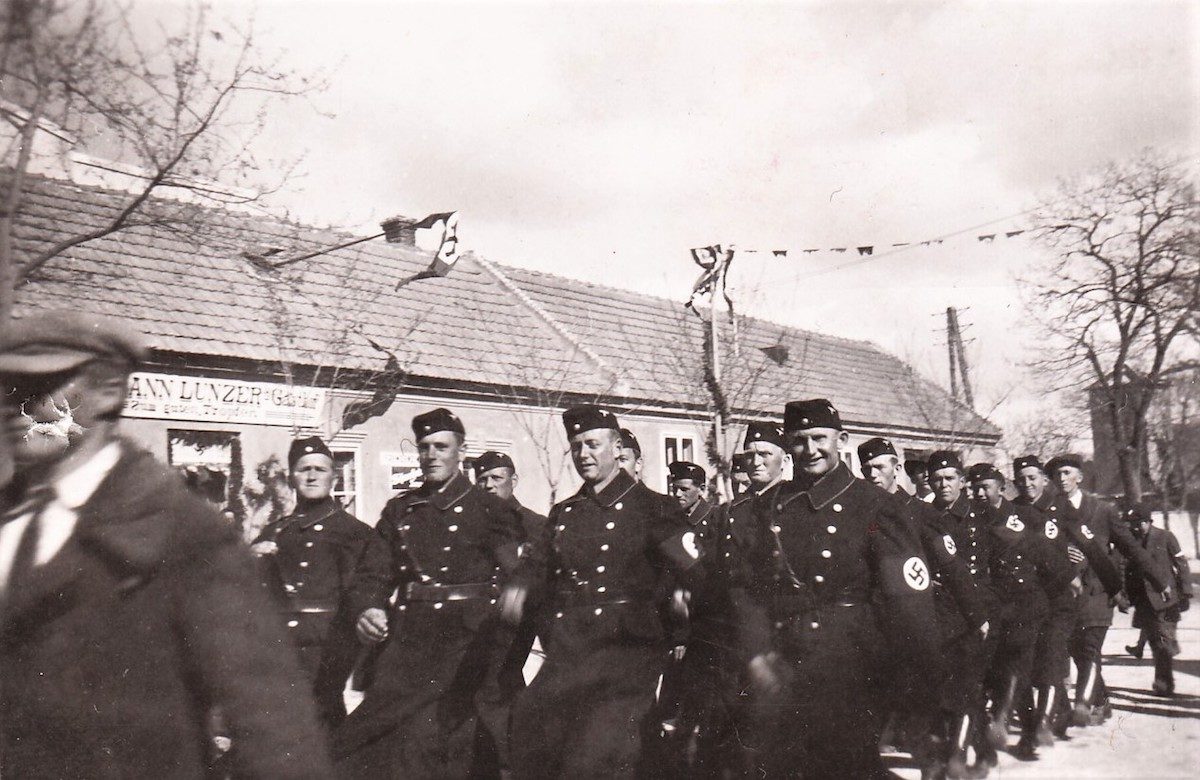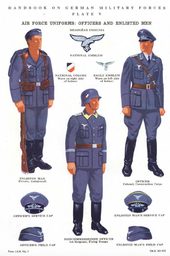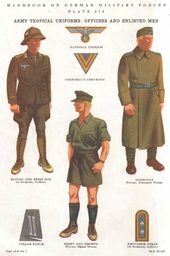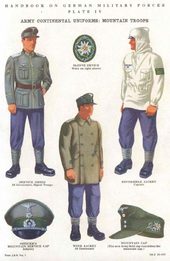This could have life or death consequences: An American squad armed with a bazooka could stand fast against a thinly armoured halftrack, but had little chance of harming the heaviest German tanks. Likewise, GIs had to be far more careful when fighting elite German infantry units than with the conscripts and armed prisoners from the eastern front that the Wehrmacht threw into the field as the conflict wore on. And so the U.S. War Department produced a 400-page book called Handbook on German Military Forces, with the purpose of giving officers and enlisted men "a better understanding of their principal enemy." A set of colour plates within the book show German soldiers in a variety of uniform styles and poses, from the Continental uniform style seen in most war movies, to tropical uniforms (which included shorts), to winter-wear for mountain troops. An updated edition of that handbook was published in early 1945. But then the war ended a few months later, and the books were discontinued: The war-fighting machine that Handbook on German Military Forces described no longer existed.
But now, more than 70 years after the fall of Berlin and the death of Adolf Hitler, it might be time for a new kind of Nazi field guide. On one hand, we are plagued by men such as Robert Bowers, who allegedly committed mass murder at a Pittsburgh synagogue after posting explicitly anti-Semitic messages on a web site known to be a haven for self-described neo-Nazis and Holocaust deniers. On the other hand, the Internet is now so full of spurious allusions to Nazi ideology that the term is in danger of losing all meaning. On social media, especially, "Nazi" has become a sort of four-letter synonym for "alt-right," which itself now fills in lazily for "conservative" or "right-wing." So even a politician or pundit who is mildly right-of-centre is in danger of being libelled as a "Nazi" by people who couldn't find Germany on a map or name a single major Second World War battle.
And so, in the spirit of the Handbook on German Military Forces, I offer readers this brief field guide to the various kinds of "Nazis" who inhabit the world of 2018.
1. Real Nazis
The full name of the Nazi party was Nationalsozialistische Deutsche Arbeiterpartei, or National-Socialist German Workers' Party, which took the official acronym NSDAP. The word "Nazi" was a term of abuse popularized by Hitler's opponents, as it derived from a condescending term used to describe Bavarian yokels. Which is to say, real Nazis of the pre-WWII and WWII era almost never would have referred to themselves as "Nazis."
Whole bookshelves could be filled with tomes about the fine points of Nazi ideology. But ultimately, what is important for our purposes is that Nazi Germany was a totalitarian police state run by Hitler - and so Nazi ideology was whatever Hitler said it was at any given moment. Like Joseph Stalin and totalitarian communists, Hitler would change his ideology to suit his circumstances. But at the core of his system of beliefs were the precepts of hate contained in Mein Kampf (a turgid and repetitive 1925 tome that I once was required to read as research for a book about conspiracy theories) and his speeches. Hitler came to view the German race as existing at the pinnacle of human development, atop an imagined racial hierarchy that he conjured out of pseudoscience. He ghoulishly would adapt emerging theories of medicine and hygiene to metaphorically cast Jews as a sort of pestilence whose extermination was required to safeguard the health of society. The Nazis managed to kill 6-million Jews, and started a war that would claim more than 70-million lives. For these reasons, among many others, Nazism is properly understood to be a byword for human evil.
A real Nazi - or, if you prefer, "literal Nazi" - was someone who (if he or she survived long enough) would support or execute the German-led effort, under Hitler, to dominate Eurasia through a warmongering, totalitarian system of government informed by genocidal racial supremacism. Very few of the real Nazis who survived the end of the Nazi regime are still alive today, and fewer still would express lingering adherence to Nazi ideology. Moreover, the whole architecture of Nazi ideology was based on the formation of a viable mainstream German political movement oriented toward the creation of a world-conquering white supremacist prison state. Thankfully, no such movement exists. Which means that real Nazis are effectively extinct.
2. Would-Be Nazis
A would-be Nazi is a modern person who fully understands and appreciates the true, malignant nature of Nazi ideology as it historically manifested itself in the 1930s and 1940s, yet nonetheless puts this ideology forward as a template for political action. Which is to say, a would-be Nazi is someone who seeks to implement a totalitarian program of world domination, cites racist pseudoscience as a fundamental organizing principle of his worldview, and urges the systematic extermination of Jews and other peoples imagined to be inferior. I confess that I have never met such an individual. But no doubt, they do exist.
3. Nazi Apologists
A Nazi apologist is someone who is not a real Nazi, and is not a would-be Nazi, but who seeks to contextualize the horrors inflicted on the world by Hitler through the conceit of utilitarian calculus. While the Nazi apologist usually will not defend the Holocaust or the other defining horrors inflicted by the Nazis, he may seek to cast the Nazis as a lesser evil when compared to the scourge of communism, "Jewish capitalism", or the imagined horror of blutschande (blood mixing). The dark standing joke of the insidious anti-Semite who notes approvingly that Hitler "made the trains run on time" is an example of the Nazi apologist.
4. Neo-Nazis / Faux-Nazis
This is a broad category, which covers individuals who seek to adapt, borrow or venerate selected elements of Nazi ideology as a means to advance their own racist or anti-Semitic agenda. Because I am Jewish, I periodically have been targeted (always, as it turned out, harmlessly) by self-described neo-Nazis on obscure web sites and social-media threads. I also interviewed neo-Nazis as part of my research on conspiracism. The average neo-Nazi I have met is quite ignorant about the actual history of the Nazi movement (and of history more generally). Many neo-Nazis will fixate strongly on the performative aspects of Nazism - such as the salutes, uniforms, military decorations, as well as the nomenclature and honorifics that were used to describe Hitler and other famous Nazi officials. (In some cases, this seems to be connected to repressed sexual fixations, though I am unaware whether this phenomenon has been studied systematically.) The unstable social and organizational dynamics of neo-Nazi groups suggest they are populated in large part by troubled - and often psychiatrically unstable - personalities.
I sometimes use the term "faux-Nazi" interchangeably with neo-Nazi because activists in this category, despite their hateful feelings and ostensible homage to the Nazi tradition, actually tend to explicitly deny a core element of Nazi ideology - specifically, the historical fact of the Holocaust. A prominent example would be Canadian-German holocaust denier Ernest Zündel, who distributed tracts with names such as The Hitler We Loved and Why, and believed that Hitler and other senior Nazis escaped to Antarctica, where they developed secret weapons and rebuilt their movement. Like many anti-Semites classified under the heading "neo-Nazi," Zündel fantastically mischaracterized the Nazi movement he sought to rehabilitate.
5. Theatrical Nazis
When I was in high school, there was a disturbed student who liked to carve swastikas into desks. When I found his swastikas, I would fill out the carving so as to turn the thing into a box divided into four sections, and it became a sort of game between us until he gave up and began restyling himself as an apolitical goth. When we both got older, I asked him about the Swastika fixation, and he confessed to me that, at the time, he really had known very little about the Nazis, but had determined (correctly) that posturing as a supporter of Nazism was a sure-fire way to attract attention. This is an example of someone who is not a Nazi in any substantive sense, except that he properly understood Nazi symbolism to be shocking. If he had been able to achieve the same effect by sketching the Soviet hammer and sickle, or pentagrams, I suspect he would have done that, too.
6. Non-Nazis
As noted earlier, there is an unfortunate tendency to conflate all manner of conservative (or populist) thought under the label of "Nazi." This ahistorical misusage is directed commonly, for instance, at pundits or politicians who seek to limit immigration or to enact policies aimed at the cultural assimilation of foreigners. (This would include U.S. President Donald Trump, who often speaks phobic, untrue and hateful things about Muslims and Mexican immigrants.) In some cases, it is claimed that these non-Nazis exhibit behaviours that suggest them to be Nazis in embryo - because "this is how the Nazis started."
But as offensive, dangerous and intimidating as such figures may be, they typically have little true actual connection to the set of ideas that Nazism came to represent. That's because the Nazis who burned Europe did not seek to assimilate or exclude so-called "inferior" peoples. They sought to enslave or annihilate them.
The essence of Nazism came to be that the moral worth of a human is encoded in his or her blood according to the hierarchy of race. Which meant that Germans had an imagined responsibility to go into foreign lands and perform acts of murder for their own sake. Jews, in particular, were compared to parasites and bacteria-creatures that are dealt with through extermination, not assimilation. This is why Hitler put Jews in concentration camps where they could be killed en masse, or hunted down in the villages of eastern Europe by einsatzgruppen.
History is full of genocidal slaughter. In ancient times, it was seen as perfectly normal for invading armies to annihilate whole towns and cities. But the Nazi regime was the first to use industrial methods and modern propaganda techniques to expand this ancient evil into something resembling a factory assembly line on a large scale. It is this combination of ancient barbarism and modern methods that has made Nazism the most despised ideology known to the modern political lexicon.
Nazism also distinguished itself historically because the genocidal acts it inspired unfolded during an era when photography was in widespread use, and the people of Europe were almost universally literate. Medieval armies left only ruins and corpses. But the Nazis and their victims left us a whole multimedia archive - from Leni Riefenstahl's Triumph of the Will to Anne Frank's diary. We know what Nazis looked and sounded like. We know how they marched, soldiered, massacred and died. Even genocides that took place much later in the 20th century, such as Pol Pot's atrocities in Cambodia and the Rwandan Genocide of 1994 are not nearly so richly documented.
This aspect of Nazi history is useful for researchers. But there is a darker side to this as well: The unusually rich collection of photos, newsreels, books, ideas, personalities and quotations that emerged from the Nazis period is such that anyone seeking to attack his or her enemies by cherry picking history can usually find some stray image or set of words from the Nazi historical record that aligns, in some way, with the object of attack. George W. Bush was compared to Hitler by some liberals when he invaded Iraq. Barack Obama was compared to Hitler by some conservatives, who claimed that the Affordable Care Act mandated the use of "death panels." Take enough pictures of a person going about their daily activities, and you will eventually get a shot of them giving something that looks vaguely like a Nazi salute.
Indeed, there is a perverse incentive for modern activists to imagine that we inhabit an age in which Nazis are powerful and ascendant - because this conceit gives moral grandeur to their own activism: It allows them to position themselves as moral heirs to the French Resistance, the martyrs of the Warsaw Ghetto Uprising, and the Allied armies that defeated the Nazi menace.
Sometimes, the supposed Nazis who are targets of these spurious verbal attacks, if they are eccentric malcontents or pathological attention-seekers, will even invite such comparisons by festooning their social media with Nazi symbols, pledges or dimly understood non sequiturs culled from Nazi sources. (A prominent example in Canada would be fringe YouTuber and former mayoral candidate Faith Goldy.)
These individuals are offensive, ignorant and often psychologically disturbed. Sometimes they are genuinely dangerous or even engage in acts of murder. But to imagine that they are "Nazis" is almost invariably wrong - even if they use that term themselves as a means to lend ghoulish historical grandeur to their vile acts. What I have written here will, I hope, discourage such crude distortions of language. But I also invite readers to do their own research, so that they may educate themselves about this uniquely dark chapter in the history of humankind.
Jonathan Kay is Canadian editor of Quillette. Follow him on Twitter at @jonkay.







Comment: The author's clarification of what Nazis are, and aren't, while informative, is likely to dissuade few activists from utilizing the term as a wholesale stand-in for "person I disagree with". While the efforts above are important to keep in mind, the unfortunate fact of the matter is that the actual truth of the term is being drowned out in the modern media landscape by its hyperbolic usage and losing all meaning.
See also: